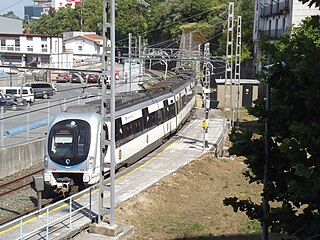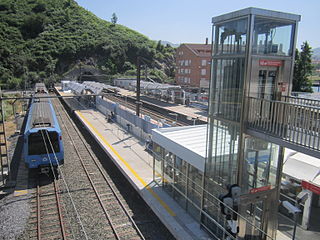
Euskotren Trena, formerly known just as Euskotren is a commuter, inter-city and urban transit train-operating company that operates local and inter-city passenger services in the provinces of Biscay and Gipuzkoa, in the Basque Country, Spain. It is one of the four commercial brands under which Euskotren operates, as a public company managed by the Basque government. The entire 181.1-kilometre (112.5 mi) network uses 1,000 mm narrow gauge rail tracks which have been owned by the Basque Government since their transferral from the Spanish government; the rail tracks and stations were part of the FEVE network until its transferral. Euskotren Trena also operates the Donostia/San Sebastián metro under the brand Metro Donostialdea.

Euskotren Tranbia is the brand under which the tramway networks in the cities of Vitoria-Gasteiz and Bilbao are run. The system in Bilbao started operations in 2002, and the one in Vitoria-Gasteiz in 2008. It is one of the four commercial divisions under which Euskotren operates. The infrastructure is owned by the public entity Euskal Trenbide Sarea and tracks use 1,000 mm narrow gauge.

The Bilbao metro is a rapid transit system serving the city of Bilbao and the region of Greater Bilbao. Lines 1 and 2 have a "Y" shape, as they transit both banks of the river Ibaizabal and then combine to form one line that ends in the south of Bilbao. Line 3 has a "V" shape connecting the municipality of Etxebarri with the Bilbao neighbourhood of Matiko; the apex of the "V" is Zazpikaleak/Casco Viejo station, where all three current lines meet. The metro is connected with the Bilbao tram, Bilboko Aldiriak, Euskotren Trena, Feve, Renfe long-distance trains, and Bilbao's bus station. All three lines use metre gauge.
Euskotren, formally known as Basque Railways, is a public railway company controlled by the Basque Government and officially established in 1982 to operate several 1,000 mm narrow gauge railways inside the autonomous community of the Basque Country, under the terms of the Statute of Autonomy of the Basque Country. Originally operating under the commercial brand ET/FV, it took control of the management and operations of the narrow gauge lines formerly operated by the railway company FEVE. The commercial brand eventually changed to Euskotren, as it remains today. Since 2006, the infrastructure on which the company runs its trains has been owned by Euskal Trenbide Sarea.

Euskotren operates frequent commuter rail services in the city of San Sebastián and the surrounding Donostialdea area, in the Basque Country, Spain. The infrastructure is gradually being upgraded to rapid transit standards, in order to create the San Sebastián Metro. The line is commonly known as Topo, due to the large number of tunnels present. As of 2021, the San Sebastián suburban rail services are branded as part of the Euskotren Trena network, with no separate identity.

Line 3 of the Bilbao metro is a rapid transit line in Biscay, Basque Country, Spain. It is 5.9 km (3.7 mi) long and connects Etxebarri and the Uribarri and Otxarkoaga-Txurdinaga districts in Bilbao with the city center.

The Euskotren 900 series is an electric multiple unit (EMU) train type operated by Euskotren in the Basque Country, Spain.

The Euskotren TD2000 series is an electro-diesel locomotive type operated by Euskotren in the Basque Country, Spain.

The Euskotren 300 series is an electric multiple unit (EMU) train type operated by Euskotren in the Basque Country, Spain from 1990 to 2018.

The Euskotren 200 series is an electric multiple unit (EMU) train type operated by Euskotren in the Basque Country, Spain from 1986 to 2018.

Sondika is a railway station in Sondika, Basque Country, Spain. It is owned by Euskal Trenbide Sarea and operated by Euskotren. It lies on the Txorierri line.

Larrondo is a railway station in Loiu, Basque Country, Spain. It is owned by Euskal Trenbide Sarea and operated by Euskotren. It lies on the Txorierri line.

Lekunbiz is a railway station in Zamudio, Basque Country, Spain. It is owned by Euskal Trenbide Sarea and operated by Euskotren. It lies on the Txorierri line.

Zamudio is a railway station in Zamudio, Basque Country, Spain. It is owned by Euskal Trenbide Sarea and operated by Euskotren. It lies on the Txorierri line.
Kurtzea is a railway station in Lezama, Basque Country, Spain. It is owned by Euskal Trenbide Sarea and operated by Euskotren. It lies on the Txorierri line.

Lezama is a railway station in Lezama, Basque Country, Spain. It is owned by Euskal Trenbide Sarea and operated by Euskotren. It lies on the Txorierri line.

The Lutxana–Sondika line is a single-track branchline in Biscay, Basque Country, Spain. Owned by Euskal Trenbide Sarea, it runs from Lutxana to Sondika, connecting line 1 of the Bilbao metro with the Txorierri line. It is a remnant of the former Lutxana–Mungia line, which was partially closed in May 1975.
Euskotren is a public railway operator in the Basque Country, Spain. Its rolling stock is formed by electrical multiple units used for Euskotren Trena commuter rail services, trams running on the Bilbao and Vitoria-Gasteiz tramway networks, and locomotives for hauling freight trains.

The FEVE 3500 series is an electric multiple unit (EMU) train type operated by Renfe Feve in Spain. The first units entered service in the Basque Country in 1977, these trains were later transferred to Euskotren, where they were known as the Euskotren 3500 series. Euskotren retired its last 3500 trains in 2013, but some units are still in service in Asturias.

The Txorierri line, also known as the Bilbao–Lezama railway is a narrow-gauge railway in Biscay, Basque Country, Spain. Owned by Euskal Trenbide Sarea, it runs from Lezama to Matiko, from where it continues as line 3 of the Bilbao metro.
















